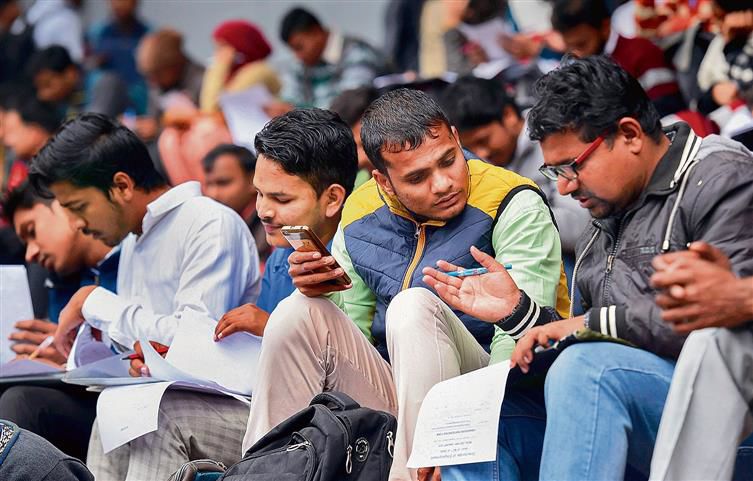
Necessary: What India’s youth need urgently is a pathway to work opportunities. PTI
Santosh Mehrotra
Research Fellow, IZA Institute of Labour Economics, Germany
IN its manifesto for the 2024 elections, the Congress announced a right to apprenticeship (RA) for all post-secondary certificate/degree/diploma holders. It guarantees all under-25-year-olds the right to apprenticeship with firms where the youth can get training and work together, based on the duality principle of the Germanic skilling model (involving schooling and simultaneous work experience). India has always had a supply-driven vocational skilling ecosystem, where youth are getting educated but not ‘skilled’ in a true sense, where there is very little employer connect and no requirement for internship or apprenticeship. This calls for a scrutiny of the performance of the government’s skill development initiatives in India and why reforms like an RA are a step in the right direction.
Vocational education and training (VET) has been neglected in India for over half a century until the 2000s (just as school education had remained neglected in India’s planning strategy) — the costs of which we continue to pay today. In 1991, when India’s economic reforms began, literacy was 51 per cent — or half of India’s population was illiterate, mostly concentrated in the agriculture sector. Although school education received a new-found emphasis in public spending in the 1990s, VET still continued to be neglected (although that was not the case for technical higher education). The 11th Five-Year Plan (2007-12) was the first Plan that had a chapter on skill development.
The result is that India’s manufacturing and services workforce still has very low levels of education. Worse, the National Sample Survey Office’s Employment-Unemployment Survey (2011-12) says 2.2 per cent of the workforce had received formal VET. Periodic Labour Force Survey (PLFS) data shows that the percentage of formally vocationally trained individuals decreased from 2.2 per cent (10.43 million) in 2011-12 to 2 per cent (9.14 million) in 2017-18, but in five years, rose to 3.7 per cent (21.05 million) in 2022-23. So, who have been added as ‘vocationally trained’?
PLFS 2017-18 shows that 22 per cent of total vocationally trained undertook less than six-month courses, and that share has now risen to 37 per cent. More worryingly, in 2017, 29 per cent individuals used to take two-year or longer courses, now reduced to 14.29 per cent. The VET duration of Skill India Mission courses is very short (in some cases, only 10 days).
Since 1961, India has had the Apprentices Act, which requires all registered firms to accept apprentices for at least one year or more. Ten years ago, about 250,000 apprentices existed in registered non-farm enterprises. In August 2016, the government of India launched the National Apprenticeship Promotion Scheme (NAPS), worth Rs 10,000 crore. Though the objective was to train 50 lakh apprentices by 2020, only 20 lakh could be trained by 2022. Out of the envisioned Rs 10,000 crore, only around Rs 650 crore was disbursed to states between 2017 and 2022. NAPS-2 was launched in 2023; no figures for the same are currently available.
An International Labour Organisation study in 2022 concluded that the amendments to the 1961 Act have contributed to an increase in the number of apprentices in India. In a workforce of 570 million in 2022-23 (PLFS), the apprentices were just over a half million, a rise from 2.5 lakh 10 years ago. Clearly, the amendments have not worked wonders. This is not surprising, given that practically the entire private corporate sector has largely ignored the apprenticeship schemes. Only central and state public enterprises have tended to fulfil their obligations. MSMEs still continue to ignore the scheme. The result: Germany, with a 46-million workforce, has at least 6 million apprentices; India has, by contrast, half a million. The difference arises from the industry/employer involvement in pre-employment training — which makes India’s approach supply-driven, but successful VET programmes around the globe have been demand-driven.
What India’s youth need urgently, as 6 million or more join the labour force each year, and over 100 million wait in the wings as NEETs (Not in Education, Employment or Training), is a pathway to work from their education, whether the education is of a general academic nature or vocational or technical. This requires that the Central Government think seriously and urgently about involving employers/industry in the skilling process.
The urgency arises from the following facts: The India Skills Report 2021 argues that nearly half of India’s graduates are unemployable. Open unemployment was barely 2.1 per cent in 2012 and had already nearly tripled to 6.1 per cent in 2018, the highest rate in 45 years of India’s labour force surveys. The number of unemployed was one crore in 2012; it tripled to three crore by 2018. The youth unemployment rates went through the roof for those with middle school (Class VIII) education, rising from 4.5 per cent to 13.7 per cent; those with secondary education (Class X) from 5.9 per cent to 14.4 per cent; and with higher secondary (Class XII) education from 10.8 per cent to 23.8 per cent. Educated unemployment worsened sharply. For graduates, the unemployment rate rose from 19.2 per cent to 35.8 per cent; and for postgraduates from 21.3 per cent to 36.2 per cent (2022-23).
In the light of educated unemployment, a lack of takers of skill programmes, low-quality training and abysmal placement rate, there is an urgent need for a comprehensive overhaul of the skill ecosystem. India, suffering from unemployment among the highly educated, in the future is moving towards the problem of skill underutilisation and overeducation (or ‘degree mania’). Mere rhetoric and inflated government statistics will no longer suffice. It is imperative that the government prioritises quality over quantity, ensuring that every individual emerges from these programmes truly equipped to contribute meaningfully to the workforce. Anything less would be a disservice to the aspirations of millions seeking a better future through skill development.
Skill policies and schemes have failed; they need a big overhaul on the lines of Swiss and Germanic skill models, in which the youth and the industry take centre stage. A Right to Apprenticeship for every youth should be an urgent priority.
Join Whatsapp Channel of The Tribune for latest updates.




























